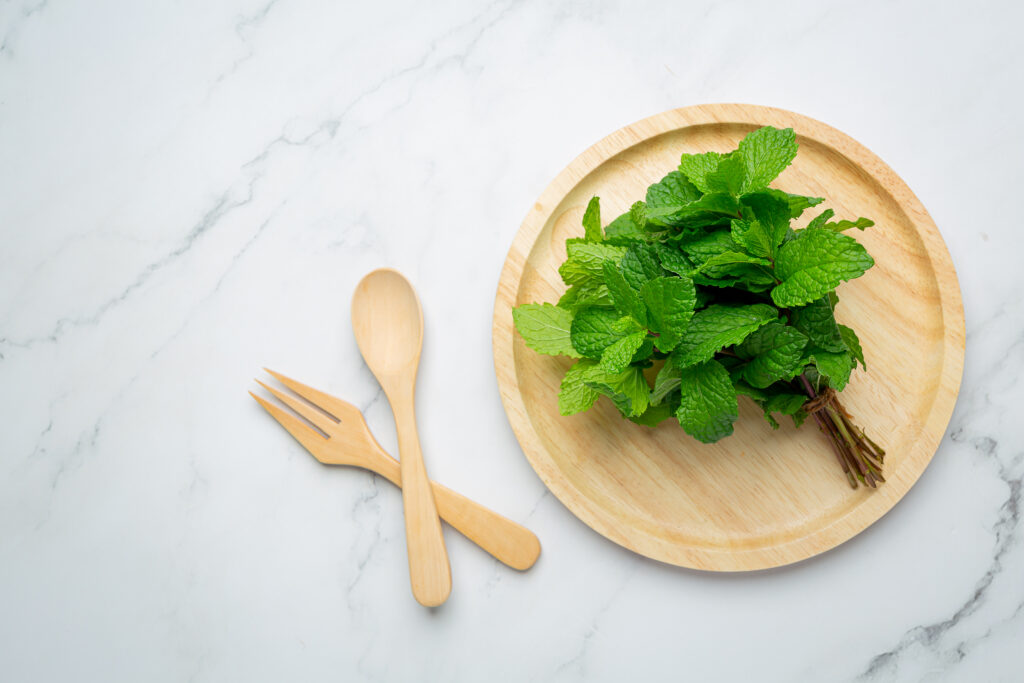
I’m a huge fan of peppermint. And this time of year there is no shortage of peppermint-flavored foods and beverages to enjoy. Since it’s one of the iconic flavors of the holidays, now is the perfect time to do a peppermint primer. I can’t guarantee that all minty goodies have health benefits (looking at you, candy canes and peppermint mochas). But there are definitely some perks to including peppermint in your diet.
What exactly is peppermint?
The peppermint plant is actually a hybrid between two types of mint: spearmint and water mint. Its flavor comes mainly from its menthol content, which also contributes to the cooling sensation it can provide. (Spearmint hardly has any menthol, and a sweeter taste.)
Where to find peppermint
If you’re looking for fresh peppermint, it can be a challenge unless you grow it yourself. Most of the fresh mint in the supermarket is spearmint (especially if it’s just labeled “mint”). Here are a few other places where you might find peppermint at your market:
- Peppermint extract in the spices section (sometimes you can find dried peppermint there too)
- Naturally caffeine-free peppermint tea in the coffee and tea aisle, along with peppermint coffee syrup
- Peppermint oil capsules or liquid in the supplements section
- Peppermint-flavored foods in their respective sections (such as candies, cookies, and the ice cream aisle)
How to use peppermint
Consumers typically use peppermint for cooking and medicinal purposes. Food and beverage manufacturers usually use peppermint extract, which is a combination of peppermint oil and alcohol. Fresh peppermint can be used in many ways. Add it to fruit salads, grain salads, and green salads. Make mint syrup or mint tea. Add a few leaves to a holiday punch or adult beverage. Or use it to perk up a protein smoothie or milkshake. Here are a couple of Guiding Star-earning minty recipes to consider:
How to use peppermint extract
Fresh peppermint can be especially hard to find in the winter months. So peppermint extract is often the best choice for home cooks to get that snappy mint flavor. (Usually just a few drops do the trick.) Don’t count on health benefits from the extract—that hasn’t really been studied. But that won’t stop me from using it this season. Here are my favorite ways to use peppermint extract:
- To flavor coffee or hot cocoa
- In peppermint cookie dough
- To whip up some festive whipped cream
- For minty homemade marshmallows
You can also swap fresh peppermint leaves for peppermint extract in certain recipes, such as homemade ice cream.
Are you a fan of using peppermint essential oil for aromatherapy purposes (like I am!)? If so, do not assume it’s safe to add to food or beverages. Essential oils are highly concentrated substances, and most are not approved for oral ingestion.
Peppermint for medicinal use
Peppermint has been used as an herbal medicine for thousands of years. You might even have peppermint tea on hand for helping with an upset stomach—one of the herb’s more common uses. There is even some research that shows enteric-coated peppermint oil capsules can improve abdominal pain and IBS symptoms. Peppermint oil can also help relieve menstrual cramps, likely because peppermint can have muscle-relaxing effects. There is a distinct lack of research, however, on the efficacy or safety of eating a lot of fresh peppermint. Peppermint essential oil may be safely applied topically for muscle aches, joint pain, and headaches if mixed with a “carrier” oil. But be sure to read the label on your essential oil to determine if it’s safe to use on skin. Because of the menthol, peppermint and peppermint essential oil may also help with respiratory symptoms during a cold.
Who should avoid peppermint?
Consuming peppermint isn’t safe for everyone. If you have acid reflux, or are prone to holiday heartburn, you may want to steer clear. It’s also best to avoid anything mint-flavored if you have gastro-esophageal reflux disease (GERD). Since peppermint can relax GI muscles it becomes easier for stomach acid to come back up, making your symptoms worse. And in general, peppermint should not be given to infants and very young children unless prescribed by a doctor. (Also, do not apply peppermint oil to an infant’s face—it can cause severe breathing problems.) Finally, there is very little known about the safety of consuming peppermint oil during pregnancy. Be sure to consult with your physician before taking any.